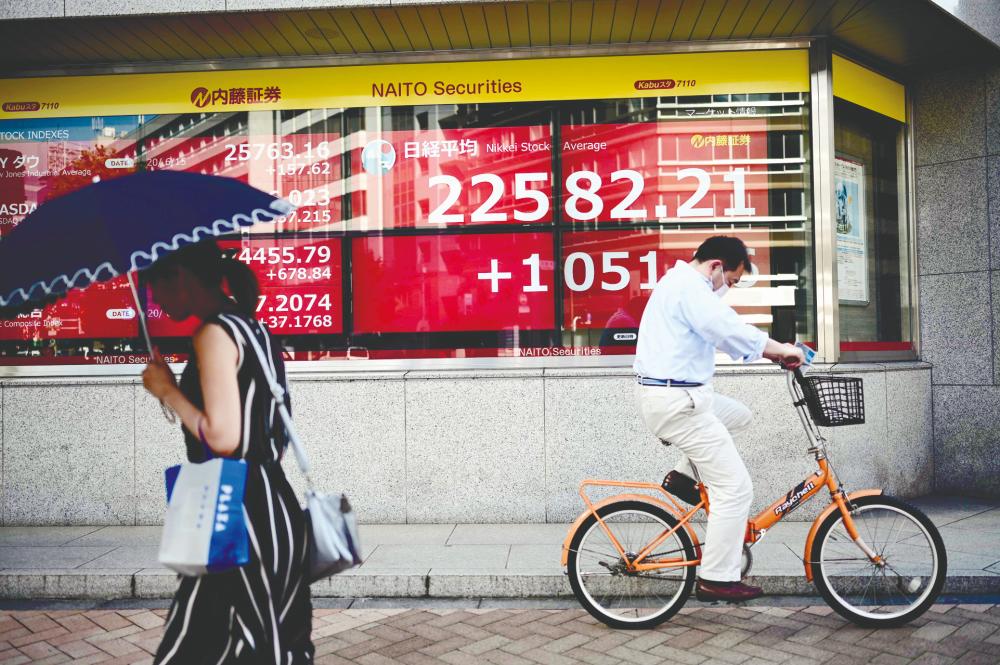PETALING JAYA: The Malaysian stock market’s recent bullish run might be a cause for celebration for investors, but given that the FBM KLCI’s change in fortune since its 11-year low in March is mainly attributed to the liquidity injection orchestrated by central banks to manage the public health crisis – what will happen when the pump priming stops?
According to Rakuten Trade’s head of research Kenny Yee, the uptrend will continue as liquidity remains intact, at least for the next few weeks.
“Right now, given the low returns from bank deposits, investors prefer to take their money out for the possibility of higher returns from the equity market,” Yee told SunBiz.
“This is evident by the ongoings on Bursa which have seen the foreign outflow trends in the local equity market staunched by local retail and institutional investors.”
He acknowledged that there is an element of optimism in the rally, as the uncertainty of a second wave of Covid-19 spread could dampen uptrend, but ultimately it will hinge on liquidity.
Yesterday, the FBM KLCI ended 18.88 points or 1.26% to end the day at 1,517.71 from Monday’s close of 1,498.83. The index opened 20.09 points higher at 1,518.92 and hovered between 1,517.47 and 1,528.76 throughout the trading session.
Overall market breadth was positive with gainers outnumbered decliners 947 to 175, however, total volume decreased to 7.97 billion shares worth RM4.14 billion from Monday’s 9.07 billion shares worth RM5.32 billion.
Yee pointed out that Bursa Malaysia’s rally is not an isolated case as regional markets are also propped by liquidity.
He noted that for now there are more negative headlines than positive ones for the local bourse and corporate earnings for the coming quarter will provide a clearer picture on the pandemic’s impact on the equity market.
Affin Hwang Capital shared the view that concerted efforts by central banks and governments worldwide to stimulate their economies have aided the gains in the KLCI, which in turn has seen a sharp increase in retail investor participation.
“Near term, with the market’s continued focus on vaccine hopes, the end of a deep economic contraction, the reopening of economies and expectations of V-shaped economic recoveries, Covid-19 and its implications seem to be a thing of the past.
“This myopic view also fails to take into account the post-Covid-19 challenges including the impact of social distancing on consumption spending patterns and even travel,” it said.
For the index, Affin Hwang arrived at a fair value of 1,332 based on a target PE of 17x, or -1SD of its 5-year mean PE on its 2020 market earnings.
In view of the market liquidity and strong retail participation, there is a possibility of the KLCI trading at even more exuberant multiples or a frothy valuation range of between 1,642 and 1,876, it noted.
“However, we reckon that a combination of improving fundamentals and liquidity would be the necessary cocktail for a further re-rating. For now, we caution that investors are walking a tightrope as liquidity can evaporate as rapidly as it came,” it added.
The research house cautioned that three factors will have to come into play if the current rally is to have any meaningful impact.
These are: global equity markets sustain their current uptrend on the back of unlimited quantitative easing; the rubber gloves rally spills over to the broader market; and the rubber gloves sector’s rally sustains.
Thus far, the performance of the KLCI is largely driven by Top Glove Corp Bhd and Hartalega Holdings Bhd, which are up year to date by 255.3% and 127%, respectively.
Retail participation is likely centred on smaller caps which are still underperforming the KLCI. Thus, until there is rotation of interest into the broader market, any stock price correction in glove stocks could result in a sharp pullback in the KLCI.
As for the possibility of a V-shaped recovery, MIDF Research pointed out that such a recovery could only be achieved and sustained if the virtuous economic circle of employment-consumption-revenue-investment-employment can be revived and safeguarded.
“However, without the Covid-19 vaccine, the economic consequence of social distancing rules on consumption and investment would remain a drag to output revival and growth in the foreseeable future,” it said in a report.
The research house also pointed out that the US Federal Reserve chair Jerome Powell had alluded to a slower than desirable pace of economic recovery, and could turn what initially deem as liquidity problems into solvency problems among both the households and businesses.
Furthermore, it stated that China’s decision to abandon an economic growth target for 2020, the first time since 2020, as a telltale sign that the post-lockdown recovery period is not expected to be plain sailing for the world economy.












